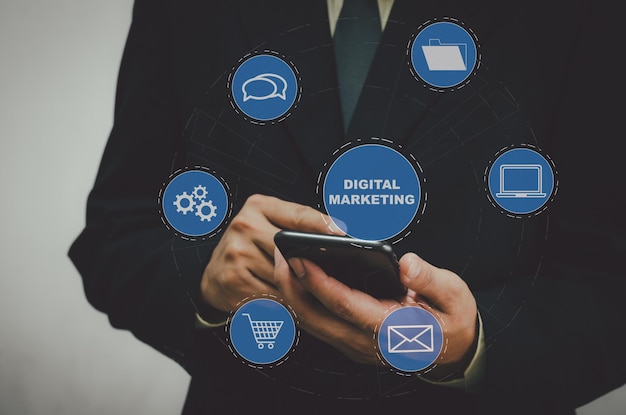The digital marketing landscape is ever-evolving, driven by rapid technological advancements, changes in consumer behavior, and shifts in market dynamics. As we move into 2024, staying ahead of the curve is essential for businesses aiming to maintain a competitive edge. This comprehensive guide explores the key digital marketing trends for 2024, providing insights and strategies to help you navigate the future of digital marketing.

Table of contents
- 1. The Rise of AI and Machine Learning
- 2. Voice Search Optimization
- 3. The Power of Video Marketing
- 4. The Evolution of Social Media Marketing
- 5. Content Marketing and the Role of AI
- Importance of Data Privacy
- 7. The Role of Influencer Marketing
- 8. Omnichannel Marketing
- 9. Sustainability and Social Responsibility
- 10. The Future of E-Commerce
- Conclusion
1. The Rise of AI and Machine Learning

AI-Powered Personalization
Artificial Intelligence (AI) and machine learning are revolutionizing digital marketing by enabling highly personalized customer experiences. AI algorithms analyze vast amounts of data to understand consumer behavior, preferences, and purchasing patterns. This allows marketers to deliver tailored content, product recommendations, and advertisements to individual users, enhancing engagement and conversion rates.
Practical Applications:
- Personalized Email Campaigns: AI can segment audiences and create personalized email content based on user behavior and preferences.
- Chatbots and Virtual Assistants: AI-powered chatbots provide instant customer support and personalized recommendations, improving customer satisfaction and retention.
- Dynamic Content: Websites can use AI to display dynamic content that changes based on user interactions and preferences.
Predictive Analytics
Predictive analytics uses AI and machine learning to forecast future trends and behaviors based on historical data. This helps marketers make data-driven decisions, optimize campaigns, and anticipate customer needs.
Practical Applications:
- Sales Forecasting: Predictive analytics can forecast sales trends and help businesses plan their inventory and marketing strategies accordingly.
- Customer Churn Prediction: Identifying customers at risk of churn allows businesses to take proactive measures to retain them.
- Campaign Optimization: Marketers can predict which campaigns will perform best and allocate resources more effectively.
2. Voice Search Optimization

Growing Popularity of Voice Assistants
The use of voice assistants like Amazon’s Alexa, Google Assistant, and Apple’s Siri is on the rise. As more consumers use voice search to find information, products, and services, optimizing for voice search has become crucial for digital marketers.
Voice Search SEO
Voice search queries are typically longer and more conversational than text searches. To optimize for voice search, marketers should focus on natural language, long-tail keywords, and question-based queries. Ensuring that website content is structured to answer common questions can improve visibility in voice search results.
Practical Applications:
- FAQ Pages: Create FAQ pages that address common questions related to your industry, products, or services.
- Conversational Content: Write content in a conversational tone that mimics how people speak.
- Local SEO: Optimize for local searches by including location-specific keywords and phrases.
3. The Power of Video Marketing

Short-Form Video Content
Short-form videos, such as those found on TikTok, Instagram Reels, and YouTube Shorts, have gained immense popularity. These platforms offer a unique opportunity for brands to engage with younger audiences through creative and entertaining content.
Practical Applications:
- Product Demos: Create short, engaging videos demonstrating how your products work.
- User-Generated Content: Encourage customers to create and share videos featuring your products.
- Behind-the-Scenes: Share behind-the-scenes content to humanize your brand and build a connection with your audience.
Live Streaming
Live streaming continues to grow in popularity, offering real-time engagement and interaction with audiences. Platforms like Facebook Live, Instagram Live, and YouTube Live allow brands to host live events, Q&A sessions, product launches, and more.
Practical Applications:
- Live Q&A Sessions: Engage with your audience by answering their questions in real-time.
- Product Launches: Host live product launches to generate excitement and build anticipation.
- Virtual Events: Conduct virtual events, webinars, and workshops to provide value and connect with your audience.
4. The Evolution of Social Media Marketing

Social Commerce
Social commerce integrates e-commerce functionality directly into social media platforms, allowing users to purchase products without leaving the app. This trend is set to grow in 2024, with platforms like Instagram, Facebook, and Pinterest enhancing their shopping features.
Practical Applications:
- Shoppable Posts: Create shoppable posts that allow users to purchase products directly from your social media feed.
- In-App Checkout: Enable in-app checkout to streamline the purchasing process and reduce friction.
- Influencer Collaborations: Partner with influencers to promote your products and drive sales through social commerce.
Augmented Reality (AR)
Augmented Reality (AR) is transforming social media marketing by providing interactive and immersive experiences. AR filters and lenses on platforms like Instagram and Snapchat allow users to engage with brands in a fun and innovative way.
Practical Applications:
- AR Filters: Develop branded AR filters that users can apply to their photos and videos.
- Virtual Try-Ons: Use AR to enable virtual try-ons for products like clothing, accessories, and makeup.
- Interactive Campaigns: Create interactive AR campaigns that encourage user participation and sharing.
5. Content Marketing and the Role of AI

AI-Generated Content
AI-generated content is becoming more sophisticated, enabling marketers to create high-quality, engaging content at scale. Tools like OpenAI’s GPT-4 can generate blog posts, social media updates, and even video scripts, saving time and resources.
Practical Applications:
- Content Creation: Use AI tools to generate content ideas, draft articles, and create social media posts.
- Content Personalization: Personalize content for different audience segments based on their preferences and behaviors.
- Content Curation: Automate content curation to deliver relevant and timely information to your audience.
Interactive Content
Interactive content, such as quizzes, polls, and interactive infographics, enhances user engagement and provides a more immersive experience. This type of content encourages participation and can lead to higher conversion rates.
Practical Applications:
- Quizzes and Polls: Create quizzes and polls to engage your audience and gather insights.
- Interactive Infographics: Develop interactive infographics that allow users to explore data and information.
- Personalized Recommendations: Offer personalized recommendations based on user interactions with your content.
6. Data Privacy and Ethical Marketing
Importance of Data Privacy

As concerns about data privacy grow, consumers are becoming more cautious about sharing their personal information. Marketers must prioritize data privacy and adopt transparent and ethical practices to build trust with their audience.
Compliance with Regulations
Regulations such as the General Data Protection Regulation (GDPR) and the California Consumer Privacy Act (CCPA) have set strict guidelines for data collection and usage. Marketers must ensure compliance with these regulations to avoid penalties and maintain customer trust.
Practical Applications:
- Transparent Data Policies: Clearly communicate your data collection and usage policies to customers.
- Opt-In Mechanisms: Implement opt-in mechanisms for data collection and provide options for users to manage their preferences.
- Secure Data Storage: Ensure that customer data is stored securely and access is restricted to authorized personnel.
7. The Role of Influencer Marketing

Micro-Influencers
Micro-influencers, who have smaller but highly engaged followings, are becoming increasingly valuable for brands. They often have niche audiences and can provide authentic and relatable endorsements.
Practical Applications:
- Niche Campaigns: Collaborate with micro-influencers to target specific niches and communities.
- Authentic Content: Leverage micro-influencers to create authentic and relatable content that resonates with their audience.
- Long-Term Partnerships: Build long-term partnerships with micro-influencers to foster loyalty and trust.
Performance-Based Influencer Marketing
Performance-based influencer marketing focuses on measurable outcomes, such as clicks, conversions, and sales. This approach ensures that influencer campaigns deliver tangible results and a higher return on investment (ROI).
Practical Applications:
- Trackable Links: Provide influencers with trackable links and discount codes to measure campaign performance.
- Performance Metrics: Set clear performance metrics and goals for influencer campaigns.
- Incentive Programs: Implement incentive programs that reward influencers based on their performance.
8. Omnichannel Marketing

Seamless Customer Experience
Omnichannel marketing integrates various online and offline channels to provide a seamless and consistent customer experience. This approach ensures that customers can interact with a brand across multiple touchpoints without friction.
Practical Applications:
- Unified Messaging: Maintain consistent messaging across all channels, including email, social media, website, and in-store.
- Cross-Channel Integration: Integrate online and offline channels to provide a cohesive customer journey.
- Personalized Experience: Use data from various touchpoints to deliver personalized experiences to customers.
Multi-Device Targeting
With consumers using multiple devices throughout their purchasing journey, multi-device targeting ensures that marketing efforts reach them at the right time and place.
Practical Applications:
- Responsive Design: Ensure that your website and marketing materials are optimized for all devices.
- Cross-Device Tracking: Implement cross-device tracking to understand customer behavior and preferences.
- Targeted Campaigns: Create targeted campaigns that reach customers on their preferred devices and platforms.
9. Sustainability and Social Responsibility

Green Marketing
Consumers are increasingly prioritizing sustainability and environmental responsibility. Brands that demonstrate a commitment to green practices can build trust and loyalty among eco-conscious consumers.
Practical Applications:
- Sustainable Practices: Implement sustainable practices in your business operations and supply chain.
- Eco-Friendly Products: Develop and promote eco-friendly products and packaging.
- Green Messaging: Communicate your commitment to sustainability through your marketing efforts.
Social Responsibility
Social responsibility involves addressing social issues and contributing positively to society. Brands that take a stand on important issues and demonstrate social responsibility can build a strong emotional connection with their audience.
Practical Applications:
- Cause Marketing: Partner with charitable organizations and promote social causes that align with your brand values.
- Community Engagement: Engage with your local community through volunteer efforts and community support.
- Inclusive Marketing: Create inclusive marketing campaigns that reflect diversity and promote equality.
10. The Future of E-Commerce

Mobile Commerce
Mobile commerce, or m-commerce, continues to grow as more consumers use their smartphones for shopping. Optimizing for mobile devices is essential for providing a smooth and convenient shopping experience.
Practical Applications:
- Mobile Optimization: Ensure that your website and online store are fully optimized for mobile devices.
- Mobile Payment Options: Offer mobile payment options, such as Apple Pay and Google Wallet, to streamline the checkout process.
- Mobile Apps: Develop mobile apps to enhance the shopping experience and provide additional features and convenience.
Augmented Reality in E-Commerce
Augmented Reality (AR) is transforming the e-commerce experience by allowing customers to visualize products in their environment before making a purchase. This technology enhances the online shopping experience and reduces the likelihood of returns.
Practical Applications:
- Virtual Try-Ons: Implement virtual try-on features for products like clothing, accessories, and makeup.
- Product Visualization: Allow customers to visualize furniture and home decor items in their space using AR.
- Interactive Product Demos: Use AR to create interactive product demos that provide a more immersive shopping experience.
Conclusion
As we move into 2024, staying informed about the latest digital marketing trends is crucial for businesses aiming to thrive in an increasingly competitive landscape. By embracing AI and machine learning, optimizing for voice search, leveraging the power of video marketing, and adopting a customer-centric approach, brands can create engaging and personalized experiences that drive growth and loyalty.
Moreover, the focus on data privacy, social responsibility, and sustainability highlights the importance of ethical and transparent marketing practices. By prioritizing these trends and implementing the strategies outlined in this article, businesses can navigate the future of digital marketing with confidence and success.


